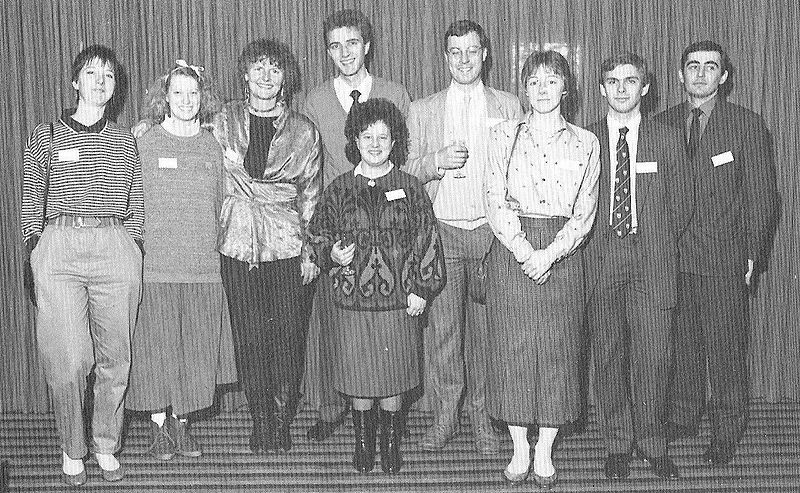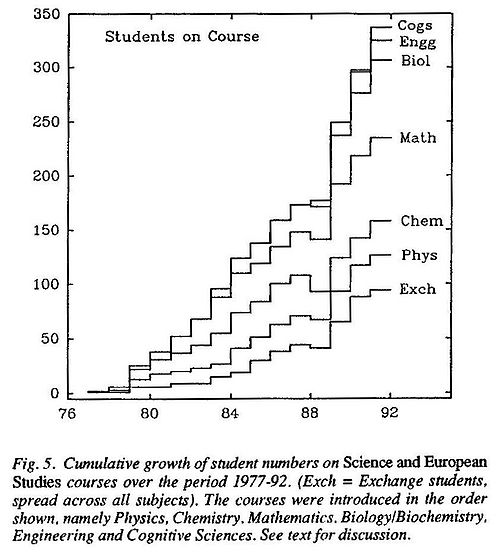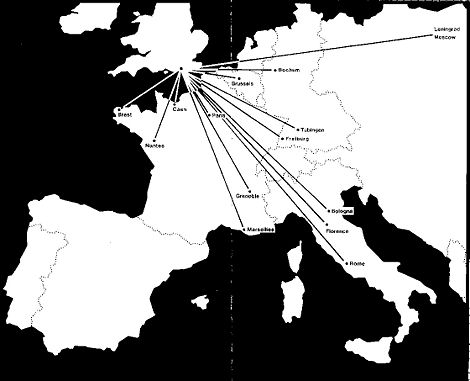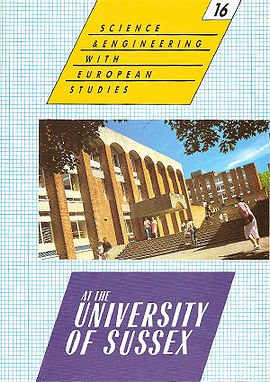| (57 intermediate revisions by 2 users not shown) | |||
| Line 1: | Line 1: | ||
| − | = | + | = Physics with European Studies - John Venables = |
| − | == | + | == Introduction and Summary == |
In October 1977, Valerie Scholes arrived in Sussex to study a new degree: Physics with European Studies (PEur). | In October 1977, Valerie Scholes arrived in Sussex to study a new degree: Physics with European Studies (PEur). | ||
| − | This was to be a 4-year degree, with the third year spent abroad, studying her subject (Physics) in her chosen language (German). Thus the Science and European Studies program had | + | This was to be a 4-year degree, with the third year spent abroad, studying her subject (Physics) in her chosen language (German). Thus the Science and European Studies program had its first student. |
| − | As of 1987-1988, we had more than 130 students in similar 4-year courses in Chemistry (CEur, from 1978 with David Walton), Mathematics, and Mathematics with Statistics (MEur and MSEur, from 1979, with James Hirschfeld) and Biology (BEur, from 1979 with several faculty). Engineering was added later. | + | As of 1987-1988, we had more than 130 students in similar 4-year courses in Chemistry (CEur, from 1978 with David Walton), Mathematics, and Mathematics with Statistics (MEur and MSEur, from 1979, with James Hirschfeld) and Biology (BEur, from 1979 with several faculty). Engineering was added later. At the same time, we had 43 exchange science students from continental Europe studying at Sussex, making a total of 173 students involved. This was not counting the long-running Swedish exchange scheme started and run by [http://history.phys.susx.ac.uk/People#In_memoriam Dennis Hamilton], and then by others, including Michael Hardiman.<br> |
| − | This important development came about in an interesting way, and I plan to write about this topic based on articles and internal Sussex Reports <references />[1, 2]<references /> that I wrote with David Walton, David Smith (Chemistry) and James Hirschfeld (Mathematics) in the late | + | This important development came about in an interesting way, and I plan to write about this topic based on articles and internal Sussex Reports <references />[1, 2]<references /> that I wrote with David Walton, David Smith (Chemistry) and James Hirschfeld (Mathematics) in the late 1980's. In my Professorial Lecture [3], I was able to highlight both my [[Research-Electron Microscopy|Electron Microscopy]] group research and the Science and European Studies program. These two topics are much more connected than might at first appear, and were a perfect example of the interaction between research and teaching, involving Exchange schemes with European Universities where Sussex faculty were well-known through research collaboration. By the early 1990's, the program had grown substantially, as documented in reference [4], and described in outline here. |
| − | It will be excellent if early PEur students in particular can describe their experiences and recollections of an exciting period in their lives, and I look forward to reading | + | It will be excellent if early PEur students in particular can describe their experiences and recollections of an exciting period in their lives, and I look forward to being in contact, and to reading anything they wish to contribute to the final section or elsewhere.<br> |
| − | == References == | + | === References === |
1. ''Scientists and Good Europeans'', in University of Sussex Annual Report 1988, pages 14-15 (John Venables) | 1. ''Scientists and Good Europeans'', in University of Sussex Annual Report 1988, pages 14-15 (John Venables) | ||
| Line 19: | Line 19: | ||
2. ''The First ten years of BScEur''. Internal University of Sussex Report (1988) 1-25 (J.A. Venables, J.D. Smith and J.W.P. Hirschfeld). | 2. ''The First ten years of BScEur''. Internal University of Sussex Report (1988) 1-25 (J.A. Venables, J.D. Smith and J.W.P. Hirschfeld). | ||
| − | 3. ''Internationalism in Science''. Professorial Lecture, University of Sussex (22nd June 1992) 1-22 (J.A. Venables)<br> | + | 3. ''Internationalism in Science''. Professorial Lecture, University of Sussex (22nd June 1992) 1-22 (J.A. Venables).<br> |
| − | + | 4. ''Science in Europe Brochure 1991-92'', Internal University of Sussex Report (April 1992) 1-27 (Greg Lawden). | |
| − | == | + | == Origins and Early Days == |
| − | + | In 1975, there was a Referendum on continued British membership of the European Community. My wife Delia and I were heavily involved on the "Yes" side. As you may recall, the Great British Public did indeed say yes, rather more out of inertia that we were already in the EEC than of conviction that we should be there, an ambivalence that continues to this day. As a minor bye-product of this event, I wrote an open letter to my Sussex colleagues, dated 11 February 1975. I suggested that since we were likely to be involved with Europe somewhat more than we had been, I would like to make some suitable initiatives, had talked to relevant Deans, was setting up a small working party, etc, and asked the Science Faculty for suggestions and help. <br> | |
| − | + | In the event, two of my four suggestions came good, namely 2) to 'set up schemes with specific European Universities for Sussex to take European students in science to do one year of their studies here, either of an exchange or one-way basis' and 3) to 'institute a 4-year degree in ''Science with European Studies'' at Sussex in which the 3rd year would be spent at a European University, as in the year abroad scheme in the School of European Studies'. | |
| + | I went on to suggest that the necessary exchanges should be pursued with those universities where we had strong research links, and that as we travelled for research purposes, which universities were interested in principle. As I remarked only half in jest, a key element of success in the university system is getting your agenda onto someone else's budget. What was involved was merely to stay an extra day to explore possibilities with the local administration. Since we already knew, via research, some of their best people on first name terms, the rest was easy. | ||
| + | The above remarks were made in 1992 [all taken from reference 3]. Of course, I don't know whether we could get away with such informal arrangements in 2011, and I'll leave that for others to comment. We intially used my own contacts for PEur: the Ruhr Universität in Bochum, and Tubingen (Germany); Université Paris XI (Orsay Campus), and Université Aix-Marseille II (Luminy Campus) (France). | ||
| − | == 4. Alumni and their Recollections == | + | The first group of students are shown in the attached figure [1], along with their German tutor, Ulrike Meinhof (3rd from left), who now holds a (Research) Chair of Cultural Studies in the Department of Modern Languages at the University of Bradford.<br> |
| + | |||
| + | [[Image:SciEur-5 001.jpg|border|center|800px|Early PEur and CEur students with their German Tutor, Ulrike Meinhof, circa Autumn 1980]] | ||
| + | |||
| + | Our first PEur graduate, Valerie Scholes (1981-Bochum) is seen 3rd from the right. Two of the others, Karen Applegate (left of picture) and Roger Hutton (behind Valerie) graduated in (1983-Freiburg). The picture must have been taken in the Autumn of 1980, when Valerie had returned from her year abroad in Bochum, and the other students were probably all in their 2nd year. The candidates for naming are 1983 graduates: Margaret Mendies (PEur-Bochum), Darren Richardson and Sandra Tomkins (both CEur-Bochum), and possibly David Crouch (PEur, Leningrad) but maybe someone else knows for sure. The 1982 graduates would have been on their year abroad, but none of those graduates studied German. | ||
| + | |||
| + | == Program Growth 1977-1992 == | ||
| + | |||
| + | The various options grew fairly rapidly, and before long outgrew the first PEur cohort, as indicated in the cumulative bar chart, taken from reference [3], which was in date as of 1992. By this time the program had reached almost 350 students, and had been extended to COGS (Computer Science) and Engineering. As can be seen, the largest groups are in Mathematics and Biology, with Physics and Chemistry fairly static. By 1992 the numbers of Exchange visitors was almost 100 each year. This, I believe was close to the maximum, but I don' t have data beyond this point. Maybe someone else has some figures, but life is short, and history is all very well, but... The Science in Europe Brochure for 1991-2, prepared by Greg Lawden (Mathematics), is impressive, and lists all the subject convenors, language and European studies teachers, and students who were on-course in any capacity that year [4].<br> | ||
| + | |||
| + | [[Image:SciEur-2 001.jpg|left|500px]]In the context of the growth of the program to this size, I would like to pay tribute to the work of the Language Centre, under several directors,including Sylvette Cormeraie-Dyke at the time this graph was prepared. The graph doesn't include the choice of languages, but all courses were offered with French and German, and several with Italian, Spanish and Russian in addition [4]. At that time the Science and Europe programs accounted for ~ 50% of their workload [3]. | ||
| + | |||
| + | In addition we had excellent courses that prepared students for general and intellectual life in Europe, especially European Economics and Politics, and the culture of each country. The leaflet below, when opened up, contains details of all these courses, which were very popular with most students.<br> | ||
| + | |||
| + | For the year abroad, we soon had a network of Universities over several subjects and countries as illustrated in the attached Map, up to date as of 1987-88 [1] and distributed in the correponding course leaflet (#16), covering ''Science & Engineering with European Studies'' by the late 1980's. | ||
| + | |||
| + | [[Image:SciEur-3 002.jpg|left|470px]]Once the students came back to Sussex for their final year, having written a dissertaion in their language, they obtained a Certificate of Language [[Image:SciEur-6 002.jpg|right|270px]]Proficiency administered by Language Centre staff. A wide-ranging Exam Board structure was set up involving the convenors and the contacts in the partner Universities, so we were sure that the students really, really, earned their language qualifications, and then their degrees. Well done, one and all! <br> | ||
| + | |||
| + | A rather complete account of the period 1977-1987 is given in reference [2], but that feels too detailed for this Wiki. Of more interest would be students' personal accounts and their own experiences, which we request them to contribute in the next section. | ||
| + | |||
| + | After this period the baton was passed to others in turn: David Walton, James Hirschfeld, David Smith, Aubrey Jenkins, Greg Lawden, Chris Mulvey, Ken Wheeler, Oliver Darlington, Jonathan Bacon, 'Jay' Jayawant, and Michael Hardiman amongst others, and I would welcome them adding a section or commenting on the pressures faced by the program after the period I have described. | ||
| + | |||
| + | My own impression was that the external environment had become much more competitive, as other Universities introduced rather similar programs. Then the question became tied to Research ratings and so on: we might have the best SciEur program, but what about the Science? In addition, it does seem that discussions got bogged down in internal accounting, the imbalance between in-bound and out-bound exchanges, and the status of the Language teachers, at the expense of the obvious value of the program. I prefer to draw a veil over all such issues: it was good while it lasted, at the very least. <br> | ||
| + | |||
| + | Having started in the sixties myself, these types of question, all too real on the ground, made me realise that the next generation needed to have go, and I had in fact already moved on. But I remain very proud of being involved in starting and running this program for 10 years; as I put it in reference [1], and was highlighted by the editor " I am proud to have catalysed a development which is very much in the Sussex tradition, which demonstrates the unity of teaching and research so clearly..." The sentence finished with "and which is attractive to good science studentse who want a challenge." Absolutely: I stand by every word of it. <br> | ||
| + | |||
| + | == Alumni and their Recollections == | ||
| + | |||
| + | This section is for future contributions from PEur Alumni and other interested parties. | ||
Latest revision as of 16:54, 22 September 2011
Contents
Physics with European Studies - John Venables
Introduction and Summary
In October 1977, Valerie Scholes arrived in Sussex to study a new degree: Physics with European Studies (PEur).
This was to be a 4-year degree, with the third year spent abroad, studying her subject (Physics) in her chosen language (German). Thus the Science and European Studies program had its first student.
As of 1987-1988, we had more than 130 students in similar 4-year courses in Chemistry (CEur, from 1978 with David Walton), Mathematics, and Mathematics with Statistics (MEur and MSEur, from 1979, with James Hirschfeld) and Biology (BEur, from 1979 with several faculty). Engineering was added later. At the same time, we had 43 exchange science students from continental Europe studying at Sussex, making a total of 173 students involved. This was not counting the long-running Swedish exchange scheme started and run by Dennis Hamilton, and then by others, including Michael Hardiman.
This important development came about in an interesting way, and I plan to write about this topic based on articles and internal Sussex Reports [1, 2] that I wrote with David Walton, David Smith (Chemistry) and James Hirschfeld (Mathematics) in the late 1980's. In my Professorial Lecture [3], I was able to highlight both my Electron Microscopy group research and the Science and European Studies program. These two topics are much more connected than might at first appear, and were a perfect example of the interaction between research and teaching, involving Exchange schemes with European Universities where Sussex faculty were well-known through research collaboration. By the early 1990's, the program had grown substantially, as documented in reference [4], and described in outline here.
It will be excellent if early PEur students in particular can describe their experiences and recollections of an exciting period in their lives, and I look forward to being in contact, and to reading anything they wish to contribute to the final section or elsewhere.
References
1. Scientists and Good Europeans, in University of Sussex Annual Report 1988, pages 14-15 (John Venables)
2. The First ten years of BScEur. Internal University of Sussex Report (1988) 1-25 (J.A. Venables, J.D. Smith and J.W.P. Hirschfeld).
3. Internationalism in Science. Professorial Lecture, University of Sussex (22nd June 1992) 1-22 (J.A. Venables).
4. Science in Europe Brochure 1991-92, Internal University of Sussex Report (April 1992) 1-27 (Greg Lawden).
Origins and Early Days
In 1975, there was a Referendum on continued British membership of the European Community. My wife Delia and I were heavily involved on the "Yes" side. As you may recall, the Great British Public did indeed say yes, rather more out of inertia that we were already in the EEC than of conviction that we should be there, an ambivalence that continues to this day. As a minor bye-product of this event, I wrote an open letter to my Sussex colleagues, dated 11 February 1975. I suggested that since we were likely to be involved with Europe somewhat more than we had been, I would like to make some suitable initiatives, had talked to relevant Deans, was setting up a small working party, etc, and asked the Science Faculty for suggestions and help.
In the event, two of my four suggestions came good, namely 2) to 'set up schemes with specific European Universities for Sussex to take European students in science to do one year of their studies here, either of an exchange or one-way basis' and 3) to 'institute a 4-year degree in Science with European Studies at Sussex in which the 3rd year would be spent at a European University, as in the year abroad scheme in the School of European Studies'.
I went on to suggest that the necessary exchanges should be pursued with those universities where we had strong research links, and that as we travelled for research purposes, which universities were interested in principle. As I remarked only half in jest, a key element of success in the university system is getting your agenda onto someone else's budget. What was involved was merely to stay an extra day to explore possibilities with the local administration. Since we already knew, via research, some of their best people on first name terms, the rest was easy.
The above remarks were made in 1992 [all taken from reference 3]. Of course, I don't know whether we could get away with such informal arrangements in 2011, and I'll leave that for others to comment. We intially used my own contacts for PEur: the Ruhr Universität in Bochum, and Tubingen (Germany); Université Paris XI (Orsay Campus), and Université Aix-Marseille II (Luminy Campus) (France).
The first group of students are shown in the attached figure [1], along with their German tutor, Ulrike Meinhof (3rd from left), who now holds a (Research) Chair of Cultural Studies in the Department of Modern Languages at the University of Bradford.
Our first PEur graduate, Valerie Scholes (1981-Bochum) is seen 3rd from the right. Two of the others, Karen Applegate (left of picture) and Roger Hutton (behind Valerie) graduated in (1983-Freiburg). The picture must have been taken in the Autumn of 1980, when Valerie had returned from her year abroad in Bochum, and the other students were probably all in their 2nd year. The candidates for naming are 1983 graduates: Margaret Mendies (PEur-Bochum), Darren Richardson and Sandra Tomkins (both CEur-Bochum), and possibly David Crouch (PEur, Leningrad) but maybe someone else knows for sure. The 1982 graduates would have been on their year abroad, but none of those graduates studied German.
Program Growth 1977-1992
The various options grew fairly rapidly, and before long outgrew the first PEur cohort, as indicated in the cumulative bar chart, taken from reference [3], which was in date as of 1992. By this time the program had reached almost 350 students, and had been extended to COGS (Computer Science) and Engineering. As can be seen, the largest groups are in Mathematics and Biology, with Physics and Chemistry fairly static. By 1992 the numbers of Exchange visitors was almost 100 each year. This, I believe was close to the maximum, but I don' t have data beyond this point. Maybe someone else has some figures, but life is short, and history is all very well, but... The Science in Europe Brochure for 1991-2, prepared by Greg Lawden (Mathematics), is impressive, and lists all the subject convenors, language and European studies teachers, and students who were on-course in any capacity that year [4].
In addition we had excellent courses that prepared students for general and intellectual life in Europe, especially European Economics and Politics, and the culture of each country. The leaflet below, when opened up, contains details of all these courses, which were very popular with most students.
For the year abroad, we soon had a network of Universities over several subjects and countries as illustrated in the attached Map, up to date as of 1987-88 [1] and distributed in the correponding course leaflet (#16), covering Science & Engineering with European Studies by the late 1980's.
Once the students came back to Sussex for their final year, having written a dissertaion in their language, they obtained a Certificate of Language Proficiency administered by Language Centre staff. A wide-ranging Exam Board structure was set up involving the convenors and the contacts in the partner Universities, so we were sure that the students really, really, earned their language qualifications, and then their degrees. Well done, one and all!A rather complete account of the period 1977-1987 is given in reference [2], but that feels too detailed for this Wiki. Of more interest would be students' personal accounts and their own experiences, which we request them to contribute in the next section.
After this period the baton was passed to others in turn: David Walton, James Hirschfeld, David Smith, Aubrey Jenkins, Greg Lawden, Chris Mulvey, Ken Wheeler, Oliver Darlington, Jonathan Bacon, 'Jay' Jayawant, and Michael Hardiman amongst others, and I would welcome them adding a section or commenting on the pressures faced by the program after the period I have described.
My own impression was that the external environment had become much more competitive, as other Universities introduced rather similar programs. Then the question became tied to Research ratings and so on: we might have the best SciEur program, but what about the Science? In addition, it does seem that discussions got bogged down in internal accounting, the imbalance between in-bound and out-bound exchanges, and the status of the Language teachers, at the expense of the obvious value of the program. I prefer to draw a veil over all such issues: it was good while it lasted, at the very least.
Having started in the sixties myself, these types of question, all too real on the ground, made me realise that the next generation needed to have go, and I had in fact already moved on. But I remain very proud of being involved in starting and running this program for 10 years; as I put it in reference [1], and was highlighted by the editor " I am proud to have catalysed a development which is very much in the Sussex tradition, which demonstrates the unity of teaching and research so clearly..." The sentence finished with "and which is attractive to good science studentse who want a challenge." Absolutely: I stand by every word of it.
Alumni and their Recollections
This section is for future contributions from PEur Alumni and other interested parties.



